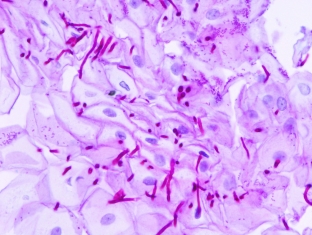Candidiasis is a common disease that belongs to the category of mycoses caused by opportunistic fungi. The increased detection of this disease in patients after surgical treatment, as well as with gynecological, urological, hematological and other disorders in recent years, increases the interest in the problem of candidiasis among doctors of various specialties. Candidiasis can appear on different parts of the body and on the mucous membranes. Read more about the causes of candidiasis in our article on estet-portal.com.
What are the provoking factors and causes of candidiasis?
In our country, at the end of the 18th century, this fungal disease was known, but numerous reports of candidiasis, which developed as a complication after antibiotic therapy, began to appear after the introduction of broad-spectrum antibiotics into practice.
According to G. A. Samsygina (1997), there is an increase in various clinical forms of candidiasis in newborns, including children infected in the early neonatal period. How infection with candidiasis can happen, read further on estet-portal.com. When using antibacterial drugs in children of somatic departments, damage to the oral mucosa caused by yeast fungi of the genus Candida is observed in 6.6%, oral and skin mucosa - in 15%, intestinal mucosa - in 2.5%, candidiasis in the intestine - in 9.2% of patients (Zh. V. Stepanova, L. L. Smolyakova, 1999).
The increase in the incidence of candidiasis is associated with the use of modern therapies (antibiotics, hormonal drugs, cytostatics, immunosuppressants), as well as with an increase in the number of diseases that create a favorable background for its development. Therefore, antibacterial agents are called relative causes of candidiasis.
Comorbid conditions that may be the cause of candidiasis:
- immunodeficiency conditions;
- endocrine gland dysfunction;
- malignant neoplasms;
- blood diseases.
The increase in the number of cases of candidiasis is influenced by increased background radiation and other factors that weaken the immune system.

Pathogens that cause candidiasis
The direct cause of candidiasis is yeast fungi of the genus Candida, widely distributed in nature and related to opportunistic pathogens. There are more than 130 species, but a little more than 10 species can be pathogenic for humans, such as C. albicans, C. tropicalis, C. krusei, etc.
The causative agents of candidiasis are isolated on average from every third person from intestines,genitals, bronchial secretions. The primary colonization of the organism occurs in the birth canal of the mother, and after birth - by contact and alimentary.
Infection of a newborn child can occur with candidiasis of the mother's nipples, through contact with the attendants of the maternity hospital, through household items, etc.
Activation of opportunistic microflora is the main cause of candidiasis
The leading factors in the appearance of candidiasis are background conditions or diseases of the body, in which opportunistic pathogens acquire pathogenic properties.
In recent years, many researchers have come to the conclusion that the main predisposing factor for the occurrence of superficial forms of candidiasis, including HIV infection and AIDS, is a violation of cellular immunity.
A certain role in the development of candidiasis is played by the frequent and not always justified prescription of broad-spectrum antibiotics, including those for prophylactic purposes, as well as the widespread use of immunosuppressive drugs - glucocorticoid hormones and cytostatics.
Candidal paronychia and onychia on the fingers, as a rule, develops in women who have frequent contact with water, while separation of the nail skin (eponychion) from the nail plate is observed, favorable conditions are created for fungal infection in the area of the matrix. The disease may occur in persons suffering from diabetes. In recent years, women have begun to use false nails, in connection with this, another risk factor for the development of fungal and bacterial infections has appeared.
Thus, the treatment of concomitant diseases, the appropriate prescription of antibiotic therapy and the increase in immunity will eliminate the causes of candidiasis.






Add a comment